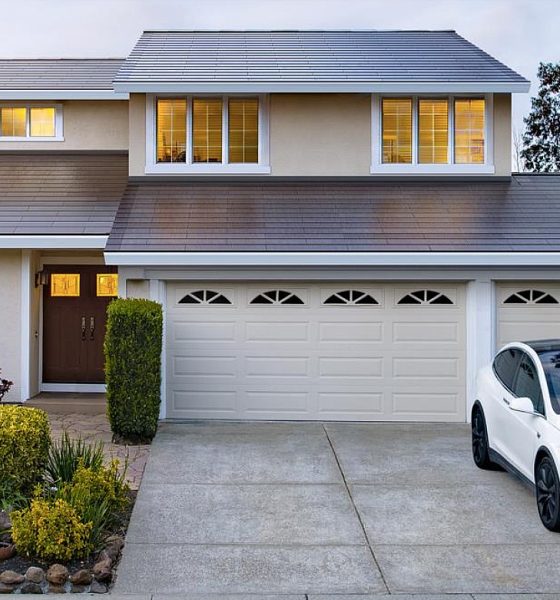Just recently, Tesla rolled out a subtle update to its official website. After welcoming the site’s visitors with its electric vehicle lineup for years, tesla.com now primarily showcases Tesla Energy products, represented by a header image featuring a home with solar panels and Powerwall batteries. The update was simple, but the company’s message was clear: Tesla Energy’s time to shine in the spotlight as arrived. The time to push battery storage and solar solutions into the mainstream market is now.
Tesla is known more as an electric vehicle manufacturer, and for good reason. The company owes its existence to the original Tesla Roadster, a small sports car that was built on a Lotus platform that broke mainstream conventions about what an electric car could be like. But the company’s mission as per CEO Elon Musk has always been clear: Tesla exists to accelerate the world’s transition to sustainability. And it just so happens that electric vehicles cannot get the job done alone.
During a previous interview with Teslarati, Robert Bollinger, the founder of Bollinger Motors, a maker of off-road, rough-and-tough EV trucks and pickups, stated that any new automaker today has to be focused on electric cars. And he’s absolutely right. It may not be universally acknowledged outright, but the automotive industry knows that electric vehicles are the way to go in order to survive the future. Full stop.
It might be a strange idea today, but there was once a time when electric vehicles were not taken seriously by the motoring industry at all. With the Model S, Model 3, Model X, and now the Model Y, Tesla has essentially pulled the automotive sector towards electric transportation kicking and screaming. After years of empty EV promises, unnecessarily complex electric concept cars that will never get mass produced, and sweet-talking statements about commitments to a zero-emissions future, legacy auto simply cannot stand by and maintain its old stance. It simply cannot afford to if it wants to survive.
The same has not happened yet to the utility sector. Renewables are on the rise, and climate action awareness is gaining ground. But overall, the idea of utilities being powered by renewables and giant batteries is still widely considered as niche ideas for now. The fossil fuel industry is still very prominent in the energy sector, and thus, the battle for sustainability on this front is only just beginning — and it will be very, very difficult. If the automotive sector was pulled into EVs kicking and screaming, the energy sector, which is dominated by the fossil fuel industry, will likely fight even harder.
This is something that supporters of Tesla and those that follow the company have to keep in mind. Tesla has struggled with misinformation for over a decade thanks to short-sellers and skeptics who simply don’t believe in electric cars or the company’s specific approach to EVs. It would thus be wise to brace for the upcoming challenges that will be brought about by Tesla quite literally taking on the fossil fuel industry, and in an arena that it has dominated for a very long time.
Fortunately, Tesla is now a mature company with an equally mature technology. Its battery tech is also second to none, as evidenced by the upcoming announcements for its highly-speculated million-mile battery. These, together with the support of an electric car business that is now the largest in the automotive industry by market cap, may very well give Tesla Energy enough power to disrupt, and eventually transition, the utility sector towards sustainability.

Energy
Tesla starts hiring efforts for Texas Megafactory
Tesla’s Brookshire site is expected to produce 10,000 Megapacks annually, equal to 40 gigawatt hours of energy storage.

Tesla has officially begun hiring for its new $200 million Megafactory in Brookshire, Texas, a manufacturing hub expected to employ 1,500 people by 2028. The facility, which will build Tesla’s grid-scale Megapack batteries, is part of the company’s growing energy storage footprint.
Tesla’s hiring efforts for the Texas Megafactory are hinted at by the job openings currently active on the company’s Careers website.
Tesla’s Texas Megafactory
Tesla’s Brookshire site is expected to produce 10,000 Megapacks annually, equal to 40 gigawatt hours of energy storage, similar to the Lathrop Megafactory in California. Tesla’s Careers website currently lists over 30 job openings for the site, from engineers, welders, and project managers. Each of the openings is listed for Brookshire, Texas.
The company has leased two buildings in Empire West Business Park, with over $194 million in combined property and equipment investment. Tesla’s agreement with Waller County includes a 60% property tax abatement, contingent on meeting employment benchmarks: 375 jobs by 2026, 750 by 2027, and 1,500 by 2028, as noted in a report from the Houston Business Journal. Tesla is required to employ at least 1,500 workers in the facility through the rest of the 10-year abatement period.
Tesla’s clean energy boom
City officials have stated that Tesla’s arrival marks a turning point for the Texas city, as it highlights a shift from logistics to advanced clean energy manufacturing. Ramiro Bautista from Brookshire’s economic development office, highlighted this in a comment to the Journal.
“(Tesla) has great-paying jobs. Not just that, but the advanced manufacturing (and) clean energy is coming to the area,” he said. “So it’s not just your normal logistics manufacturing. This is advanced manufacturing coming to this area, and this brings a different type of job and investment into the local economy.”
Energy
Tesla and Samsung SDI in talks over new US battery storage deal: report
The update was related by industry sources and initially reported by South Korean news outlets.

Recent reports have suggested that Tesla and Samsung SDI are in talks over a potential partnership to supply batteries for large-scale energy storage systems (ESS).
The update was related by industry sources and initially reported by South Korean news outlets.
ESS batteries to be built at Samsung’s Indiana plant
As noted in a report from Korea JoongAng Daily, the demand for energy storage systems has been growing rapidly in North America, thanks in no small part to the surge in AI investments across numerous companies. With this in mind, Tesla has reportedly approached Samsung SDI about a potential battery supply deal.
The deal is reportedly worth over 3 trillion Korean won (approximately $2.11 billion) and will span three years, according to The Korea Global Economic Daily. A battery supply deal with Samsung SDI could make sense for Tesla as the company already has a grid-scale battery, the Megapack, which is perfect for industrial use. Samsung SDI could simply supply cells for the EV maker.
Production of the batteries would reportedly take place at Samsung SDI’s joint venture factory with Stellantis in Indiana, which is currently under construction. Samsung SDI recently announced plans to use part of that plant’s EV lines to produce cells for ESS, with a targeted capacity of 30 GWh by the end of next year.
Tesla and Samsung’s partnership
At present, only a handful of manufacturers, including Korea’s LG Energy Solution, Samsung SDI, SK On, and Japan’s Panasonic, are capable of producing energy storage-scale batteries domestically in the United States. A Samsung SDI official issued a comment about the matter, stating, “Nothing has been finalized regarding cooperation with Tesla.”
The possible energy storage system deal adds another layer to Tesla’s growing collaboration with Samsung, which is already in line as a partner in the upcoming production of Tesla’s AI5 and AI6 chips. Early sample manufacturing of the AI6 is expected to begin in South Korea, with mass production slated for Samsung’s Texas-based Taylor foundry when it starts operations.
The AI6 chip will power Tesla’s next wave of high-volume projects, including the Optimus humanoid robot and the autonomous Cybercab service. Musk has called the partnership with Samsung a “real collaboration,” adding that he personally plans to “walk the line” at the Taylor facility to speed up progress.
Energy
Tesla VP hints at Solar Roof comeback with Giga New York push
The comments hint at possible renewed life for the Solar Roof program, which has seen years of slow growth since its 2016 unveiling.

Tesla’s long-awaited and way underrated Solar Roof may finally be getting its moment. During the company’s Q3 2025 earnings call, Vice President of Energy Engineering Michael Snyder revealed that production of a new residential solar panel has started at Tesla’s Buffalo, New York facility, with shipments to customers beginning in the first quarter of 2026.
The comments hint at possible renewed life for the Solar Roof program, which has seen years of slow growth since its 2016 unveiling.
Tesla Energy’s strong demand
Responding to an investor question about Tesla’s energy backlog, Snyder said demand for Megapack and Powerwall continues to be “really strong” into next year. He also noted positive customer feedback for the company’s new Megablock product, which is expected to start shipping from Houston in 2026.
“We’re seeing remarkable growth in the demand for AI and data center applications as hyperscalers and utilities have seen the versatility of the Megapack product. It increases reliability and relieves grid constraints,” he said.
Snyder also highlighted a “surge in residential solar demand in the US,” attributing the spike to recent policy changes that incentivize home installations. Tesla expects this trend to continue into 2026, helped by the rollout of a new solar lease product that makes adoption more affordable for homeowners.
Possible Solar Roof revival?
Perhaps the most intriguing part of Snyder’s remarks, however, was Tesla’s move to begin production of its “residential solar panel” in Buffalo, New York. He described the new panels as having “industry-leading aesthetics” and shape performance, language Tesla has used to market its Solar Roof tiles in the past.
“We also began production of our Tesla residential solar panel in our Buffalo factory, and we will be shipping that to customers starting Q1. The panel has industry-leading aesthetics and shape performance and demonstrates our continued commitment to US manufacturing,” Snyder said during the Q3 2025 earnings call.
Snyder did not explicitly name the product, though his reference to aesthetics has fueled speculation that Tesla may finally be preparing a large-scale and serious rollout of its Solar Roof line.
Originally unveiled in 2016, the Solar Roof was intended to transform rooftops into clean energy generators without compromising on design. However, despite early enthusiasm, production and installation volumes have remained limited for years. In 2023, a report from Wood Mackenzie claimed that there were only 3,000 operational Solar Roof installations across the United States at the time, far below forecasts. In response, the official Tesla Energy account on X stated that the report was “incorrect by a large margin.”










